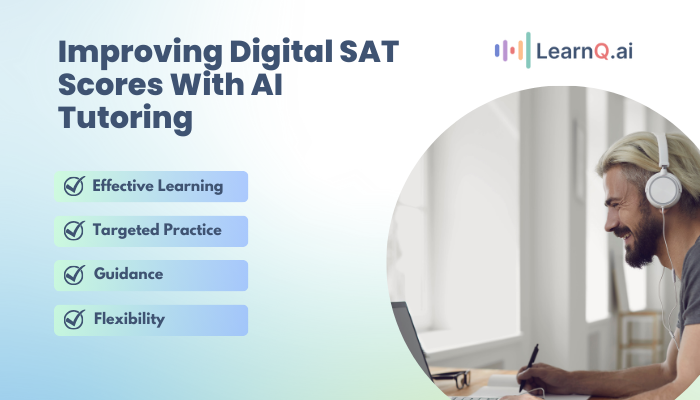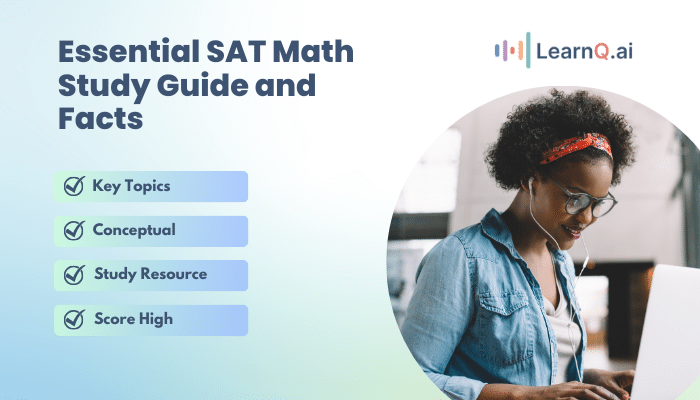The transition of the Scholastic Assessment Test (SAT) from a traditional paper-and-pencil format to a digital format reflects a response to evolving college admissions policies.
This shift is influenced by changing dynamics in higher education, where colleges and universities are reevaluating the role of standardized testing in admissions processes. The move towards digital SAT administration signifies a broader trend in educational assessment methods, aiming to adapt to the needs and preferences of students in an increasingly digital age.
But, the question that makes the students curious is- is the digital SAT easier? Let’s start to navigate through the changing landscape of standardized tests.
The Transition: Understanding the Shift to a Digital SAT
This transition is part of a larger narrative surrounding standardized testing in college admissions, with institutions exploring alternative evaluation methods to ensure fair and equitable assessment of student capabilities. The evolution of the SAT from its inception in 1926 to its current digital format underscores the ongoing dialogue on the efficacy and relevance of standardized tests in gauging academic potential and readiness for higher education.
Now that we’re up to speed on the why behind the digital leap, let’s find out if the digital SAT is easier, and the key reasons fueling this major shift.
Is the Digital SAT Easier?
The College Board, the organization responsible for the SAT, maintains that the digital SAT is not designed to be inherently easier than its paper-and-pencil predecessor. The digital SAT aims to maintain the same level of rigor as the previous format while offering a more streamlined and potentially less stressful testing experience. While certain aspects might appear easier, the core difficulty level remains unchanged.
However, several aspects of the digital format may contribute to a less stressful and potentially more accessible testing experience. Let’s get into the details;
1. Intended Difficulty Level:
- The College Board emphasizes that the content and difficulty level of the questions on the digital SAT remain comparable to the paper-based test. The goal is to maintain the same level of rigor while offering an updated and streamlined assessment.
2. Potential Benefits of the Digital Format:
- Reduced Stress: The shorter duration and fewer questions may lead to less test anxiety and fatigue, allowing students to focus more effectively on each question.
- Increased Accessibility: The digital format offers greater potential for accommodating diverse learning styles through features like text-to-speech and extended time options.
- Combined Reading & Writing Sections: Merging the Reading and Writing sections into modules potentially allows for a more cohesive assessment of critical thinking and communication skills.
3. Specific Changes Potentially Impacting Difficulty:
- Calculator Use for All Math: Allowing calculators for all math questions might benefit some students accustomed to using them in their math classes. However, strong conceptual understanding remains crucial for success.
- Adaptive Testing: While adaptive testing can provide a more personalized experience, it’s important to remember that the overall difficulty level is intended to be comparable to the paper-based SAT. Students performing well may encounter more challenging questions later in the exam, balancing the potential advantage of starting with easier questions.
All right, we’ve covered what’s changed and speculated on difficulty levels; now let’s evaluate the reasons behind the transaction.
Decode the digital STA with LearnQ.ai
Reasons for the Transition to Digital SAT

The move from a paper-and-pencil test to a digital format signifies a major step for the SAT. This shift is driven by several key motivations, aiming to:
1. Enhance Accessibility and Embrace Modern Learning:
The digital SAT aims to increase accessibility and align with modern learning experiences.
- Flexibility: The digital format allows for greater flexibility in test administration and scheduling, potentially reducing logistical challenges for students in diverse geographical locations.
- Familiarity: Many students are accustomed to utilizing technology in their daily lives and learning environments. A digital test format can potentially feel more familiar and user-friendly, potentially reducing anxiety and improving test-taking comfort.
- Accommodation Potential: The digital platform may offer greater potential for accommodating diverse learning styles and accessibility needs. This could involve features like text-to-speech conversion, magnification options, or extended time allowances based on individual requirements.
2. Reduce Stress and Increase Relevance:
The digital SAT also strives to make the testing experience less stressful and more relevant to evolving academic priorities:
- Streamlined Testing: The digital format can streamline the testing process, reducing time spent on non-essential tasks like marking answers on paper. This can potentially lead to a less stressful and time-constrained testing environment.
- Adaptability and Focus on Skills: The digital platform allows for adaptive testing, where question difficulty adjusts based on student performance throughout the exam. This can potentially create a more engaging and relevant experience by focusing on assessing skills and knowledge at an appropriate level.
- Alignment with Evolving Education: The digital format opens possibilities for incorporating multimedia elements and new question types that may better reflect the critical thinking and analytical skills prioritized in contemporary education.
By moving towards a digital platform, the SAT aims to embrace modern learning experiences, enhance accessibility, and create a more streamlined and relevant assessment for future test-takers.
With the basics out of the way, let’s try to tackle the elephant in the room – is the Digital SAT Easier, by investigating what’s changing with the digital SAT?
Go beyond the basics. Discover all the digital SAT prep material at LearnQ.ai
What’s Changing with the Digital SAT?
The transition to a digital SAT brings several notable changes to the test-taking experience. Let’s delve into the specifics:
1. Format Transition:
- Goodbye Paper, Hello Digital: The familiar paper-and-pencil format is replaced by digital testing devices, similar to tablets. These devices will be provided at test centers and pre-loaded with the exam.
- Bluebook Goes Digital: The traditional Bluebook used for essay writing will be replaced with a digital on-screen writing application. This allows for easier editing and potentially eliminates concerns about illegible handwriting.
2. Streamlined Testing Experience:
- Shorter Duration: The digital SAT boasts a reduced test duration, clocking in at 2 hours and 15 minutes compared to the previous 3 hours. This streamlined format aims to lessen fatigue and potentially improve focus during the exam.
- Fewer Questions: The number of questions has also decreased. The new format features 54 multiple-choice questions across the Reading & Writing and Math sections, compared to the prior 96 questions.
Here’s a breakdown of the new format for you:
| Section | Reading and Writing | Maths |
| Module 1 timing | 32 mins | 35 mins |
| Module 2 timing | 32 mins | 35 mins |
| Number of questions | 54 | 44 |
3. Modular Structure:
- Shifting from Sections to Modules: The SAT is now divided into two modules each for Reading & Writing and Math, instead of separate sections.
- Each module must be completed before moving on to the next, ensuring focused attention on each area.
4. Content and Adaptive Testing:
- Updated Content: While core concepts remain similar, the reading passages may be shorter and feature a wider range of topics reflecting modern educational priorities.
- Adaptive Testing: The digital platform introduces adaptive testing, where question difficulty adjusts based on your performance throughout the exam. This personalizes the experience and provides a more accurate assessment of your abilities
5. Scoring and Resources:
- Consistent Scoring: The scoring scale (200-800 per section) remains unchanged.
- Faster Results: Score reports will be delivered electronically within days of taking the test, compared to the previous weeks-long wait.
- Enhanced Career Resources: The digital platform may offer integrated career exploration tools and resources, potentially connecting students with relevant opportunities based on their test results and interests.
Uncover everything you need to know about the digital SAT. Visit Learnq AI
Adapting to the New SAT: Optimizing Your Performance
The transition to a digital SAT brings changes that may require adjustments in your test-taking approach. Here are some key strategies to ensure you adapt effectively:
1. Maintain Focus
While the streamlined format and potential reduction in stress are welcome changes, remember the College Board assures the difficulty level remains comparable. Don’t fall into the trap of overconfidence due to perceived simplicity. Maintain your focus on thorough preparation and consistent practice.
2. Retain Mental Math Skills:
While the allowance of calculators for all math questions may seem advantageous, don’t become over-reliant on it. Develop strong mental math skills by consistently practicing solving simpler problems without a calculator. This will enhance your problem-solving speed and overall mathematical understanding.
3. Embrace Familiarity:
The testing centers will provide digital devices for the exam. However, you might feel more comfortable using a familiar device for practice tests and online resources. Explore the Bluebook app and practice on a similar device to reduce potential stress and ensure smooth navigation during the actual test.
4. Stay Focused and Consistent:
The adaptive nature of the digital SAT might adjust question difficulty throughout the exam. Don’t let this affect your confidence or test-taking approach. Don’t create confusion or mess with questions like is the digital SAT easier? Is the digital SAT harder? Maintain a consistent strategy of carefully reading questions, understanding the requirements, and utilizing all available time effectively, and you will get through the test with good marks.
Get expert guidance and boost your confidence for the Digital SAT with LearnQ.ai’s AI tutor Mia.
How To Study for the Digital SAT: Tips with LearnQ.ai?
The digital SAT presents a unique opportunity to showcase your academic abilities. Here are some valuable tips to optimize your preparation, focusing on leveraging LearnQ.ai’s features:
- Diagnostic Tests: Uncover your strengths & weaknesses for targeted practice.
- Play & Practice: Sharpen your skills with interactive questions & instant feedback.
- Mock Tests: Simulate the real exam with full-length, timed tests & detailed reports.
- Ask Mia: Get 24/7 personalized support from your AI tutor, Ask Mia.
As we wrap up this journey through the digital SAT’s ins and outs, let’s look at why LearnQ.ai is your ace in the hole for conquering this new challenge.
Final Thoughts
The digital SAT marks a new chapter in the test’s history, and LearnQ.ai is at the forefront of this evolution. As the landscape continues to develop, here’s why LearnQ.ai is your ideal partner in navigating the new SAT and achieving your academic goals:
1. Future-Proof Preparation with Cutting-Edge Technology:
The digital SAT is here to stay, and LearnQ.ai embraces the future with a platform specifically tailored to its unique format. Leverage AI-powered features to gain a data-driven advantage in your preparation.
2. Personalized Learning – Your Unique Path to Success:
LearnQ.ai goes beyond generic test prep. Our platform adapts to every student’s strengths and weaknesses, providing targeted practice and real-time feedback on areas requiring improvement. This personalized approach ensures you maximize your learning potential and optimize your study efforts.
3. Convenience and Flexibility – Learning On-the-Go:
LearnQ.ai’s mobile-friendly platform empowers you to learn anytime, anywhere. Access diagnostic tests, practice questions, mock exams, and Ask Mia, your AI tutor, all from your phone or tablet. This flexibility allows you to seamlessly integrate learning into your busy schedule, maximizing your study efficiency.
4. Confidence Through Expertise – Backed by Educators and AI:
LearnQ.ai is more than just technology. It is your digital companion developed by experienced educators who understand the nuances of the SAT and the challenges students face. This expertise, combined with the power of AI, creates a comprehensive and effective learning experience.
5. A Commitment to Your Success – Join the LearnQ.ai Community:
At LearnQ.ai, we are passionate about helping students achieve their full potential. We offer a supportive community and dedicated customer support to ensure you have all the resources and guidance you need throughout your SAT preparation journey.
With the above brief discussion, we must have been able to answer your question- is the digital SAT easier?
Don’t settle for a generic approach to the digital SAT. Strategize, study, and execute, and you will be able to boost your marks in the SAT digital exam.
Embrace the future and empower yourself with the personalized learning, data-driven insights, and expert guidance offered by LearnQ.ai.
Visit LearnQ.ai today and take your first step towards SAT success!











